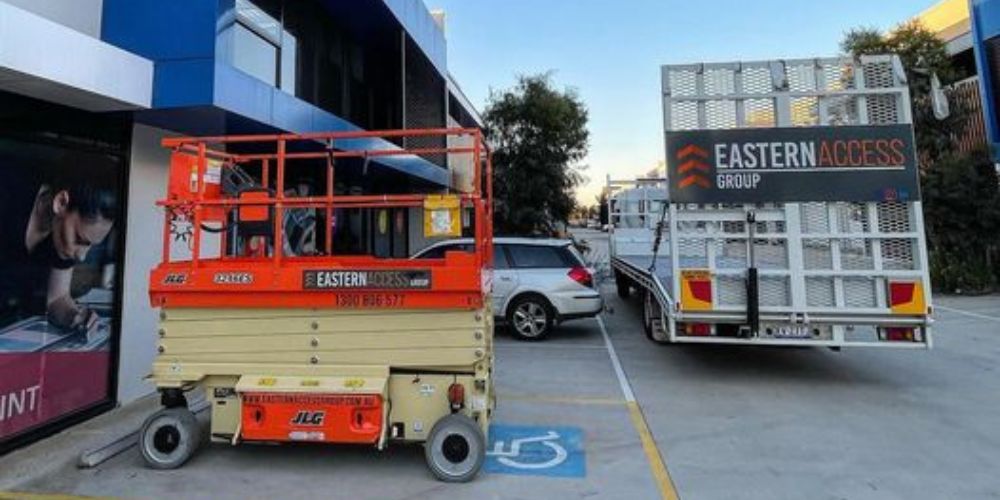Scissor Lifts vs Scaffolding: Which is Better for Your Next Aerial Work?
When working at heights, safety is always a top consideration. That includes having the proper equipment to protect you and your team.
Scaffolding has always been the solution to elevated working platforms. Aerial lifts, similar to scissor lifts, are now used as scaffolding alternatives to make the task easier and safer. Both have advantages and disadvantages; understanding the distinctions between the two is critical in determining the best option for your aerial project.
In this blog, we will talk about comparing scissor lifts vs scaffolding, addressing the differences and benefits of each, as well as the factors to consider when deciding which to use.
Table of Contents
Scissor Lifts vs Scaffolding – Which one should you use?
Scissor lifts and scaffolding vary primarily because the latter is a rigid structure that must be left in place until disassembled. The scissor lift operator may raise and drop it to various heights. Scissor lifts may also be transferred from one place to another without disassemblin
Scaffolding vs Scissor Lifts – Let’s Compare!
What is a Scissor Lift?
Scissor lifts are handy elevating work platforms that raise and lower the platform using a foldable criss-cross pantograph mechanism. They are frequently used for jobs like painting, cleaning, and building, requiring personnel to reach heights securely. Scissor lifts come in various sizes and weight capabilities and can be driven by electricity, fuel, or gas.
What is a Scaffolding?
Scaffolding is a temporary framework to support personnel and equipment during building or maintenance work. It is made of metal pipes, hardwood planks, and couplers and may be built in various heights and configurations to suit the project’s needs. Scaffolding may be altered to accommodate various surfaces and regions and is frequently used in building, painting, and maintenance jobs that need access to heights.

Comparison:
Flexibility and mobility
Since they are portable, scissor lifts are simple to transport from one place to another. They have a smaller footprint than scaffolding and can maneuver in confined locations. Scaffolding is a fixed structure that takes longer to build up and move about. Scaffolding, however, is more adaptable in terms of its use since it can be altered to accommodate various surfaces and shapes.
Size range
Scissor lifts are best used for operating at lower to mid-level heights because of their constrained height range. In contrast, scaffolding may be built to considerably larger heights, making it appropriate for more extensive constructions and skyscrapers.
Safety
Ladders and scaffolding are hazardous; using them properly requires additional workers to oversee and frequent safety inspections. Due to the materials, they are composed of having a minimal grip. They might be challenging to use in bad weather. Falls from this elevated work platform are extremely uncommon since scissor lifts have a sturdy base, outriggers that may be installed for additional safety, and high sides.
Safety factors like guardrails, harnesses, and emergency shut-off valves are standard on scissor lifts. Additionally, because of their quick operation, you may lower and reposition them more quickly during storms and strong winds. Other tools may be secured, and your team members can reach safety more quickly.
Cost
Especially for more significant or more specialised types, scissor lifts may cost more to rent or purchase than scaffolding. They can save time and money on labour expenses by enabling employees to reach heights swiftly and conveniently. Still, they can also be more productively expensive in terms of cost per unit of output.
Productivity
Scissor lifts can boost productivity by enabling workers to reach heights more quickly and effectively, resulting in quicker job completion times. Scaffolding can take longer to build up and take down, occasionally resulting in less production. However, scaffolding can offer a more extensive work surface and more configuration freedom, boosting efficiency for some activities.
Why Scissor Lifts are the Better Options Over Scaffoldings?
Scissor lifts are superior to scaffolding because they provide the following benefits:
- Because they have a more extensive base and are less prone to topple over, scissor lifts are safer and more stable than scaffoldings.
- Scaffoldings are immovable and may take up a lot of room. Still, scissor lifts offer a more significant working area and are portable.
- Because they can be controlled by a single person and may reach greater heights than scaffoldings, scissor lifts are more effective and productive.
- Workers may save time and effort using scissor lifts, which offer quick and straightforward access to heights, to do jobs more quickly and effectively.
- Scissor lifts offer various access for various tasks and are ideal for lower to mid-level heights.
Factors to Consider When Choosing between Scissor Lifts and Scaffolding
There are several things to consider into account while deciding between scissor lifts and scaffolding to guarantee the project’s safety and effectiveness:
Project specifications
When deciding whether to use scaffolding or scissor lifts, it’s vital to consider the project’s kind and height needs. Scaffolding may be ideal for large-scale building projects that require a more comprehensive working platform. However, scissor lifts may be more appropriate for minor maintenance tasks requiring greater mobility and flexibility.
Budget
Consideration should be given to the expense of renting or purchasing scissor lifts or scaffolding, especially for smaller projects. Compared to scaffolding, scissor lifts may be more expensive to buy or hire, but they may save time and labour.
Safety concerns
Considerations for worker safety include the stability and safety features of scissor lifts and scaffolding. To evaluate which choice is safer for the project, consider the working height, weight capacity, and stability.
Environmental aspects
The appropriateness of scissor lifts and scaffolding for a project might depend on the working environment, including the terrain, weather, and impediments. Scaffolding could be more suited for jobs requiring manoeuvring around obstacles. At the same time, scissor lifts are better suited for jobs on uneven terrain.
Frequently Asked Questions
It is preferable for the batteries if they are charged for a lengthy period, such as overnight, since short-term or “opportunity charging”—such as plugging in the scissor lift over lunch—can harm battery life.
Distilled water is the most typical form of water used in batteries. Deionized water and water from reverse osmosis are different kinds. The use of regular tap water is not advised since it can be too contaminated with contaminants that would reduce battery efficiency.
Because corrosion of internal battery manufacturing components is exacerbated in the acidic electrolyte at high temperatures, the battery may suffer damage. Heating is a physical result of water decrease, especially in the last phases of charge or unintentional overcharging.
Key Takeaways
The scaffolding vs. scissor lifts comparison depends on several variables, including project needs, money, time restrictions, safety concerns, and environmental implications. Both strategies offer benefits and drawbacks, and the decision relies on the project’s particular requirements. Scissor lifts offer a more significant height range, mobility and flexibility, simplicity of use, safety features, and time savings. Scaffolding, on the other hand, provides variety, adaptability, stability, and security. To guarantee the safety and effectiveness of the project, it is crucial to assess its demands and seek professional guidance thoroughly.

